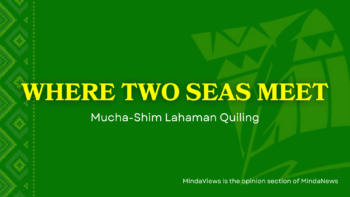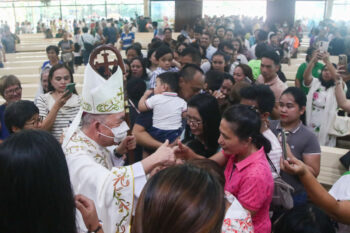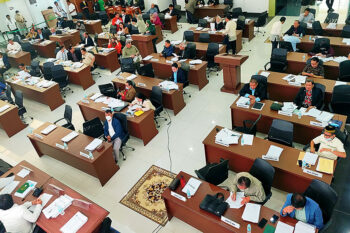GENERAL SANTOS CITY, November 15, 2014 – President Benigno Simeon C. Aquino III launched his candidacy in 2010 on the platform of “daang matuwid (straight path)” in order to eliminate corruption in government. But the platform was – and still is – locked to political patronage, the root of corruption, nurtured by the multi-party system. Does it have to be wondered that “daang matuwid” is a hollow slogan in the sea of corruption?
His political wagon, the Liberal Party, could not have carried him to Malacañang; it had to be propelled by the “Cory charisma”. LP President Manuel “Mar” A. Roxas II had to step down to the vice presidential slot, yet he lost. Other so-called political parties hitched unto the Cory charisma-driven LP wagon. Aquino III has to keep intact the LP-centered coalition as there is not enough number of LPs in the Senate and the House for him to govern. But perpetuating political patronage is perpetuating corruption.
The only way for “daang matuwid” to prevail was to have unlocked it from political patronage to free it from corruption. But that would have been suicidal – so the paradox, the contradiction of “daang matuwid” in the sea of corruption.
Corruption
Corruption is in our political system. President Manuel A. Roxas won against President Sergio Osmeña Sr. on the issue of corruption in the first post-war election of April 23, 1946. As the third President of the Philippine Commonwealth, Roxas was sworn as the first President of the present Third Republic on July 4, 1946.
Osmeña Sr. was clean, honest and decent. But the reparation goods scandal attributed to his men brought him down. By not campaigning, he avoided mudslinging he abhorred. After that election until President Ferdinand E. Marcos, with the exception of Roxas and President Ramon Magsaysay who both died in office, all three Presidents lost in their reelection bids on issues of corruption and related scandals. Marcos used his vast powers to foil the issue of corruption to get reelected,
From 1946 to 1972, two parties – the Liberal and the Nacionalista – alternated in ruling the country. There were third parties which never threatened the LP-NP monopoly. In 1972, after declaring martial law, Marcos abolished the two-party system, established the Kilusang Bagong Lipunan (Movement of New Society) as the ruling political party and vowed to stop corruption. The vow was a historic contradiction. Marcos and his wife Imelda, as conjugal patrons, openly dispensed public money by the millions.
Corruption and political patronage were most compatible bedfellows.
Multi-Party Coalition System
To have a semblance of democracy, Marcos allowed splinter national and regional parties to oppose the KBL in mock elections. Oddly, this mockery became the precursor of the multi-party system.
The 1987 Constitution instituted the multi-party system that we have today. The KBL was exiled with Marcos; the LP and the NP had been cannibalized and dumped in the junkyard. It was time for the splinter political parties to rise. However, most of these parties were personality-centered and without national directorates. Their candidates were not selected by conventions but by “anointment” by the party’s central figure or ruling clique. This was a formula for political patronage.
In reality, our multi-party system is “coalition-party system”. Parties coalesce to win the election; or, winning by insignificant plurality, their elected candidates coalesce after the election in order to govern. In the post-martial law Philippines, no political party of a winning presidential candidate alone has won majorities in the Senate and the House.
In the 1992 presidential election, the ruling LDP (Laban Demokratikong Pilipino) picked Speaker Ramon Mitra, its president, as its standard bearer. Fidel V. Ramos bolted LDP, formed his own party, Lakas Tao, and won by a mere 22 percent plurality. LDP won the Senate and the House by a landslide. But Ramos’ ally, Rep. Jose de Venecia, engineered a coalition in the House; the Senate followed. The LDPs jumped ship into Lakas-NUCD that became the new ruling party.
The same happened in the 1998 presidential election. Joseph Estrada won convincingly over De Venecia but just carried a handful of senators and House representatives. But soon the majority in Lakas-NUCD switched allegiance to Estrada. When Estrada was deposed in 2001, there were just a handful of Lakas-NUCD senators and representatives to support the new president, Gloria Macapagal-Arroyo, De Venecia’s running mate. But soon the Lakas-NUCD became the dominant party in the Congress.
Aquino III won differently but still through the same political patronage. Parties hitched to the Cory charisma-driven Liberal Party. Popular though he is, he has to keep intact the coalition; the Liberal Party alone is a minority in both the House and the Senate.
Perpetuating Corruption
In our multi-party coalition political patronage system, the President is the principal patron. The patron and patronizers are indispensable to each other as “the bow unto the arrow is”. The instrument of patronage is legal – the Congress enacts the enabling law; the President executes. For instance, if the instrument like the pork barrel involves money, the Congress appropriates, the President releases the funds. See how necessary one is to the other?
Political patronage is not just at the Executive-Legislative level. The ramifications are most extensive – from the Palace and the Congress down to the Cabinet, to the line agencies, to the local governments with the patronizers by turns becoming patrons; from the power holders to their constituents and friends in business and other private sectors.
Political patronage is principally aimed at perpetuation in power of the patrons at all levels. But this costs money. This is how political patronage corrupts.
Political Power
But power is tempting and infectious; patronizers turn against their patrons to ascend to power. This is how corruption in all its forms – misappropriation, overpricing, kickbacks, etc. – is exposed. See the PDAF scandal, the DAP controversy, the Binay “beating”, etc. the daang matuwid notwithstanding.
Political power is perpetuated through election. During elections, candidates invest on voters; on winning, they have to recover their money plus profit beyond their salaries and legitimate allowances. Between elections, they have to continue investing on projects to keep voters loyal for the next elections. To justify the PDAF, President Aquino III said legislators need to sponsor projects for their reelection – not mentioning fat kickbacks.
Political power is hereditary, hence, dynastic. Just look at your barangay hall up the Congress and Malacañang. With few exceptions, the names of the power wielders are old, familiar and traditional like the Christmas carols.
“What are we in power for?” were the immortal, as well as immoral, words of Jose Avelino, president of his wing of the Liberal Party. Power begets power. Hereditary political power by election is maintained through wealth regrettably tainted by sheer or legalized corruption. And, much more!
Term limit is constitutional prohibition against perpetuation in power. But in enacting the necessary enabling law, the legislators ridiculously fixed flexible “limit” for all elective positions, except for the President and Vice President. For local government offices and the congressional district representatives, “three consecutive three-year terms”; for senators, “two consecutive six-year terms” – but they can run for another “limit” after a lapse of one election, ever after. That’s taking Filipinos for a ride — which they enjoy!
Political dynasty is constitutional prohibition – against perpetuation and proliferation in power. But legislators have refused to enact the enabling law. So, families or clans occupy simultaneously different elective positions from the barangay up to the Congress or Malacanang. They just switch positions after the end of “term limits”.
“What are we in power for” is the refrain in perpetuity – to perpetuate political power, political patronage and corruption.
Daang Matuwid
When Aquino III put up his “Daang Matuwid” in 2010 with the complementary slogan ahead, “Kung walang kurap, walang mahirap (Without the corrupt, there would have been no poor)”, he must have seen the maze or network of “daang baku-baku (crooked paths)” infested by corruption.
What did he intend to do?
Did he intend to do this – just build his “daan matuwid” confident all will abandon the “daang baku-baku” and corruption? He showed no signs of bulldozing the “daang baku-baku”– of cleaning the “Augean stable”. In fact, instead of doing first that herculean task, he evidently tolerated his fellow riders and hitchers to his LP wagon and their corrupt baggage.
Whatever he had intended or not intend to do, the time did not hide. Three years into his term, corruption erupted. The eruption is going on.
Where now is the “daang matuwid”? Has it ever been started?
Aquino III is not a charismatic leader, not decisive. He rationalizes, is sensitive and protective of his friends, especially his appointees. Contrary to his fondness of addressing the Filipinos as “his bosses”, he lets no one second-guess “who is the boss” –.making known his preference for the Marcos Supreme Court that did not question the President’s political decisions.
Can he still do in less than two years left of his term what he has failed to do in the first four? There is no sign of uprooting political patronage and stopping corruption. (“Comment” is Mr. Patricio P. Diaz’ column for MindaViews, the opinion section of MindaNews. The Titus Brandsma Media Awards honored Mr. Diaz with a “Lifetime Achievement Award” for his “commitment to education and public information to Mindanawons as Journalist, Educator and Peace Advocate.” You can reach him at patpdiazgsc@yahoo.com.)






